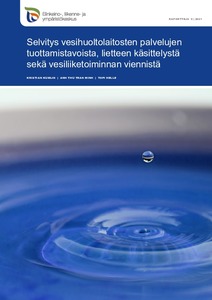The plan of water and water ecosystem protection for Karelian Pyhäjärvi
Kukkonen, Minna; Kiiski, Jaana; Luotonen, Hannu; Niinioja, Riitta (2005-01)
Avaa tiedosto
Lataukset:
Kukkonen, Minna
Kiiski, Jaana
Luotonen, Hannu
Niinioja, Riitta
North Karelia Regional Environment Centre
01 / 2005
Julkaisun pysyvä osoite on
https://urn.fi/URN:ISBN:952-11-1933-0
https://urn.fi/URN:ISBN:952-11-1933-0
Kuvaus
Regional Environmental Publications 374
Tiivistelmä
Karelian Pyhäjärvi is a valuable clear water lake located on the border between North Karelia (Finland) and the Republic of Karelia (Russia). It has been included in many national and international programs. It belongs also to the Finland’s nominations for the European Union nature protection network, Natura 2000, representing an oligotrophic habitat containing very few minerals characteristic of sandy plains. In 2002, a project was started and entitled “Assessment of the ecological state of an oligotrophic lake - as exemplified by the Transboundary Lake Pyhäjärvi on the Finnish-Russian Border”.
This water protection plan is the first report of the project. It concentrates on the Finnish side of the border summarizing the average load in to the lake, water quality and ecological state of the lake and also water protection directions. The same type of water protection plan is underway for the Russian side.
The annual nutrient load into Pyhäjärvi is about 12 000 kg phosphorus and 286 000 kg nitrogen. The main loading is caused by non-point sources. Anthropogenic impacts are mainly focused on the Finnish side of the lake. The load has decreased since the beginning of 1990s.
Lake Pyhäjärvi represents an oligotrophic and clear water lake. Monitoring of the lake started in the 1960s and has been ongoing to the present. In the 1980s and 1990s, the water quality declined, (visibility impairment, algal blooms, sliming of fishing nets, increase of roach (carp and minnows?) in fish population) but during the last ten years, nutrient concentrations have decreased and the water quality increased. The aim of this water protection plan is to reduce the nutrient load especially from non point out puts, keep the conservation of the lake ongoing and strength the fish populations, especially vendace.
This water protection plan is the first report of the project. It concentrates on the Finnish side of the border summarizing the average load in to the lake, water quality and ecological state of the lake and also water protection directions. The same type of water protection plan is underway for the Russian side.
The annual nutrient load into Pyhäjärvi is about 12 000 kg phosphorus and 286 000 kg nitrogen. The main loading is caused by non-point sources. Anthropogenic impacts are mainly focused on the Finnish side of the lake. The load has decreased since the beginning of 1990s.
Lake Pyhäjärvi represents an oligotrophic and clear water lake. Monitoring of the lake started in the 1960s and has been ongoing to the present. In the 1980s and 1990s, the water quality declined, (visibility impairment, algal blooms, sliming of fishing nets, increase of roach (carp and minnows?) in fish population) but during the last ten years, nutrient concentrations have decreased and the water quality increased. The aim of this water protection plan is to reduce the nutrient load especially from non point out puts, keep the conservation of the lake ongoing and strength the fish populations, especially vendace.
Kokoelmat
- Muut [504]
Samankaltainen aineisto
Näytetään aineisto, joilla on samankaltaisia nimekkeitä, tekijöitä tai asiasanoja.
-
Proposal of a long-term water supply network to Honde Valley Ward 10
Eriksson, Jeremias (2022)The thesis provides a technical framework of gravitationally fed water distribution systems in rural developing regions. The functionality of gravity-fed networks’ theory includes energy profiles in the network, pressures ... -
Intensification of hemicellulose hot-water extraction from spruce wood by parameter tuning
Krogell, Jens (Åbo Akademi - Åbo Akademi University, 22.05.2015)The growing population on earth along with diminishing fossil deposits and the climate change debate calls out for a better utilization of renewable, bio-based materials. In a biorefinery perspective, the renewable biomass ... -
Selvitys vesihuoltolaitosten palvelujen tuottamistavoista, lietteen käsittelystä sekä vesiliiketoiminnan viennistä
Kumlin, Kristian; Tran Minh, Anh Thu; Helle, Topi
Raportteja :9/2021 (Etelä-Savon ELY-keskus, 03 / 2021)Vesiliiketoiminta kasvualaksi -ohjelman tavoitteena on edistää vesivarojen kokonaisvaltaisessa hallinnassa ja vesipalve-luissa (esim. vesihuolto, jätevedenpuhdistus, energiatehokkuus, monitorointi ja niiden digitaaliset ...



